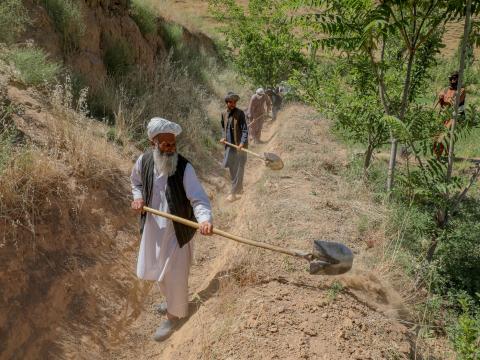Weaving Green With a Ribbon of Water

Several seasons of catastrophic droughts in Badghis province have forced many people to flee their villages for surrounding cities. Frequent crop failures have led to a collapse in income as traditional agricultural societies lost their livelihoods. Farmers in Mubarak Shah village have struggled with the problem for many years. “I remember when I was a child we would pray for rain to feed our lands,” says Abdul Azim, 56.
In the past, a narrow, man-made canal provided water for domestic use and irrigation. The canal hasn’t been serviceable for over two decades due to destructive floods and damage incurred during the civil war. Without the canals, villagers relied on rain-water for agricultural activities and most of the farmlands did not receive adequate water. “The water canal was completely damaged and no water flowed into it,” Abdul Azim explains. “In case of drought, we would not have any crops. And even if we were lucky enough to have rain, we could still only cultivate once a year.”
As a solution, in coordination with the communities and Department of Rural Rehabilitation and Development of Badghis (DRRD), ‘The Australia Afghanistan Community Resilience Scheme’ project started rehabilitation of the water canal in Mubarak Shah village. Through community participatory approach (CAP), the project constructed intake dam, aqueduct structure and canal lining. With this repairing, 67 ha of agricultural land was covered with access to water. Moreover, because of dire need for water for agriculture lands of the communities in Mubarak Shah village requested for the extension of irrigation canal. Thanks to the Livelihood recovery project funded by ‘Afghanistan Humanitarian Fund’, the canal was further extended through Cash For Activity. With that, an additional 250 ha of agricultural lands could access irrigation water. With this integration, a total number of 1,000 households in three communities of Mubarak Shah benefited from 5 km long water canal and total of 317 ha agricultural land could access irrigation water.

Drought affected families in Mubarak Shah village were supported with Cash for Work for canal rehabilitation and it had a positive impact on children as well as and the greater community. Abdul Azim used most of the money he earned on school expenditures for his 15 children. Also, he says, “We [the villagers] put some of our money together toward constructing a small bridge over the canal to access our land.”
Atef, 40, a faith-leader in Mubarak Shah, encourages and oversees local maintenance of the canal. He is happy with the support provided by WVA. “Thanks to World Vision for reaching us and addressing this problem which is very crucial for our livelihoods. I [will work to pass on knowledge of it’s] maintenance to the people of village.” The consistent flow of water has already greened the formerly parched surrounds. Children especially will see positive health impacts as crops represent crucial vitamin sources.

The types of crops grown in Mubarak Shah are generally drought tolerant, such as wheat, barley and peas. With timely water for the crop, wheat yield has been increased this season from 2,200 kg to 3,080 kg per hectare. According to Abdul Azim, “We have never [been able to grow] vegetables on this land due to lack of water.” But with a consistent water source farmers are now expanding into growing fruits and vegetables.
According to Ismail, 35, the village Headman, “Seven-hundred families directly, and 1,500 families indirectly, will benefit from this water canal. Children suffered from a lack of vitamins because there was no [source for fresh, local] vegetables.” Farmers can now cultivate the fresh food they need for their community. “At the same time,” says Ismail, “we are planting saplings which will help us have fresher air and a greener environment.”
Families like Abdul Azim’s make good use of the water canal for their income and are exploring more opportunities to better sustain their livelihoods in their historic homelands rather than having to leave for crowded, resource-strapped cities. “We’re now able to cultivate and harvest crops two times during a year,” which means more profit, more fresh food, and a more sustainable way of living going forward.
